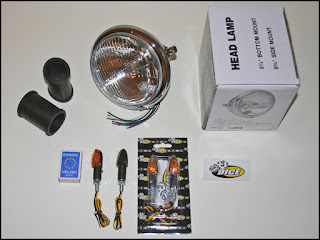I wanted to make a small and simple brat style rear fender for my T250J. The bike came with a shortened front fender which was in a good enough condition to use as blank.
 |
| Suzuki T250J front fender. |
I started by drilling out all small rivets which hold the two pieces of the fender together. I also made the rivet holes bigger by drilling them. I decided to use M6 screws so I used a 6,5 mm drill bit. I then traced an arc to the fender with a paperboard template.
 |
| A paperboard template helped to trace an arc to the fender. |
I used a battery-powered angle grinder made by Makita with 1 mm thick cutting disc to cut the arc. Once that was done I removed burrs with a sanding machine.
 |
Cut fender, a battery-powered Makita angle grinder
and a sanding machine. |
Next step was to make proper brackets to hold the fender in place. I decided to use 2 mm aluminium sheet as a material. I used M6x16 socket head cap screws, washers and M6 nyloc nuts to hold the brackets on the fender. Two M8x45 hexagon head screws hold the upper brackets and a M8x20 the right lower bracket on the frame.
 |
Upper and lower brackets and fasteners made out of
2 mm aluminium sheet. |
 |
| Measurements for upper brackets. |
 |
| Measurements for right lower bracket. |
 |
| Brat style fender ready to be mounted to my T250J. |
The bike came with an unused Michelin 3.25-18 59S M45 E2 tire so I decided to use one as a front tire also. I bought a Michelin 3.00-18 52S M45 E2 tire from my local motorcycle parts dealer Euro Motor Center.
Old tires were in a pretty bad condition. Front tire was a factory installed Inoue 3.00-18. Rear tire was a pain in the ass to remove as it was dried and cracked and wouldn't like to bend over the rim. Motion Pro tire irons helped a lot to remove those tires.
 |
| Michelin 3.00-18 52S M45 E2 front tyre and 3.25-18 59S rear tyre |
 |
| Side view with new tyres and fenders. |

























































